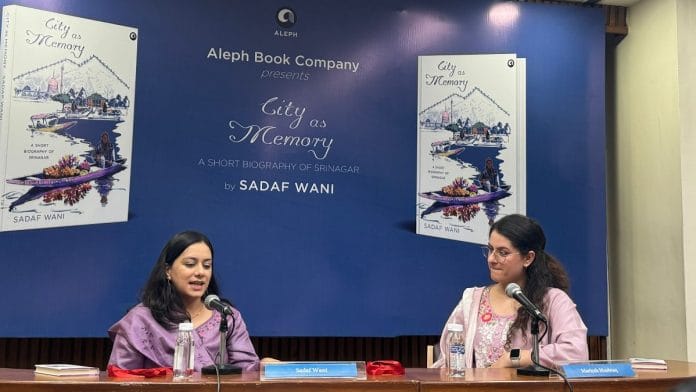New Delhi: It was 1958 when author and translator Neerja Mattoo saw The Brothers Karamazov at Regal Cinema in Kashmir. The Urdu translation of the title, Kamraj ke Bhai, was prominently written on the movie poster alongside the English title. Even those Kashmiris who couldn’t understand English attended the screenings to be part of a cultural, modern, and urban experience in the heart of Srinagar.
It’s a Srinagar that author Sadaf Wani cannot wrap her head around. At the launch of her book City as Memory: A Short Biography of Srinagar at Delhi’s India International Centre on 26 July, she kept returning to Matoo’s Srinagar.
Back then, the city thrived on diverse cultural influences. The bookshops on Residency Road stocked everything from Vladimir Nabokov’s 1955 novel Lolita to Kate Millet’s revolutionary 1970 work, Sexual Politics. Most women wore saris. Even the hippies, whom residents called “gareeb angrez (the poor English)” were part of the social milieu, said Wani, recalling her conversations with Matoo.
“I was pretty amazed, I was like, is she really talking about such things happening in Srinagar? Is this how cosmopolitan Srinagar was at one time? How different public spaces were, how a lot of people who were not Kashmiris would also live in Kashmir?” said Wani.
And then the 1990s happened. While the rest of India was dipping its toes in the waters of a liberalised economy, Kashmir was battling a rise in terrorism, and the exodus of Kashmiri Pandits.
City as Memory is a blend of the personal and the historical. Wani recounts her childhood experiences of this turbulent period— the insurgencies and protests—and interviews residents as well. It’s the Kashmir she knew.
According to Wani, when she met Mattoo to interview her for the book, she was surprised to learn about the Srinagar the former grew up with. It was diverse, modern, and welcoming.
“Neerja saw the disbelief in my eyes. So, she went and got a picture of the student union of the Government Women’s college in Srinagar. And I could see so many different people. When you lose a community [Kashmiri Pandit], there is a loss to the spirit of the city. So, this book allowed me some glimpses into that,” said Wani.
The result is a biography of sorts of a city often called “heaven on earth.”
‘Writing this book was like flipping a dice’
Wani’s homage to her hometown is a departure from the traditional description of the city, which focuses on its spatial map of places and landmarks. It offers an alternate map instead – comprised of people’s accounts of what the city looked like.
When her editor at Aleph Book Company commissioned a biography on Srinagar, Wani’s first instinct was to write about women, leisure and public spaces. But after several conversations with her editor, she decided to navigate the city through the lived experiences of people—a lifeworld framework.
“Writing this book was like flipping a dice. You see a number, you see different stories. But if you flip the dice once again, you will get a completely different set of people, different experiences and that kind of fundamentally alters how you see things,” she said.
Her entry point into understanding Srinagar was through her father’s stories and memories of the place. Her father, Nazir, was a resident of Downtown Srinagar before he moved to Baramulla. Every time the family travelled from Baramulla to the city, he would share stories about its roads, corners, and alleys.
Wani doesn’t only talk of violence in her book; she also delves into the fault lines of caste, freedom and the experiences of Kashmiri Pandits. She widens her gaze to talk about the stigma and discrimination faced by the people of the highly vulnerable Haenz community that has historically lived on houseboats on the Dal Lake.
She also explores residents’ ideas of leisure and recreation, and the lack of inclusive spaces for young men and women. Couples started to avoid meeting in the city because of the “paranoia of being seen with the boyfriend,” she wrote in her book.
Also read: Jammu terror attacks should worry Modi 3.0—Article 370 abrogation not enough to stop Pakistan
Women lead the show
The launch of City as Memory was an all-women show. From moderator Mariyeh Mushtaq, who is an independent researcher and visual artist, to the author herself, every important person at the gathering was a woman.
As the discussion drew to a close, a gentleman in his 60s, seated in the front row, rose to question the author.
“What would happen to Kashmiri dishes, now that women in Kashmir have started working? Has it changed the rich food tradition?”
The question left the women in the audience appalled. Wani, who visibly looked shocked, answered with aplomb.
“I think there has to be a general update in men’s thinking since cooking is not women’s domain. It’s a life skill that everybody should have. So I think generally there is, I hope, more of a sense of equal responsibility,” she said.
Another person wearing a red robe, who claimed to be a sadhu, inquired whether women in Srinagar had started walking outside like those in Mumbai, Delhi and other metro cities.
Wani responded by saying that her book had not explored the topic, adding that women’s ability to walk and work is influenced by many factors in Kashmir.
“If you have a certain caste, class, or privilege, and you live in an urban centre, you have more privilege. If you live in a village, it will be different,” she said.
The audience, who had been listening to her with rapt attention, applauded the author for handling such questions with calm and grace.
“Had a man launched a book [like this], would he be asked the same questions?” said one woman as people gathered their belongings to leave the venue.
(Edited by Zoya Bhatti)






